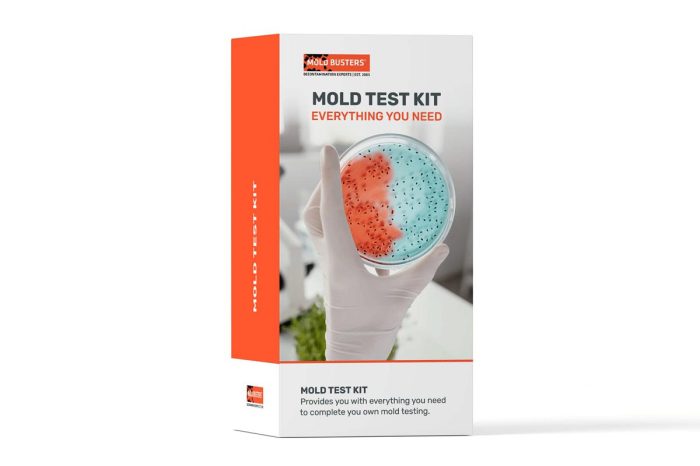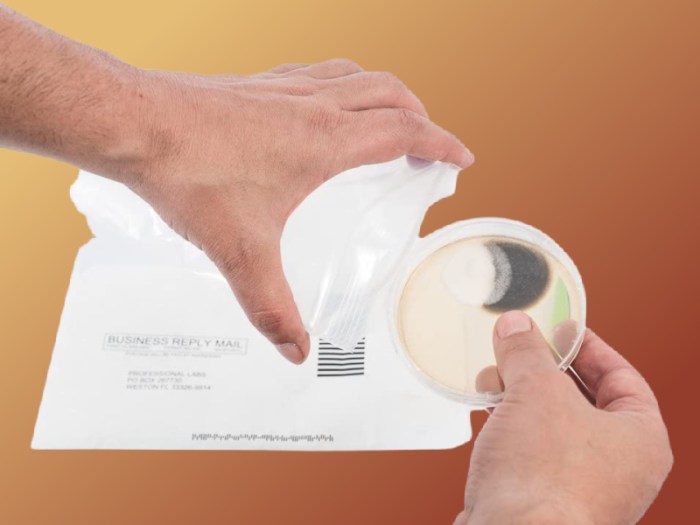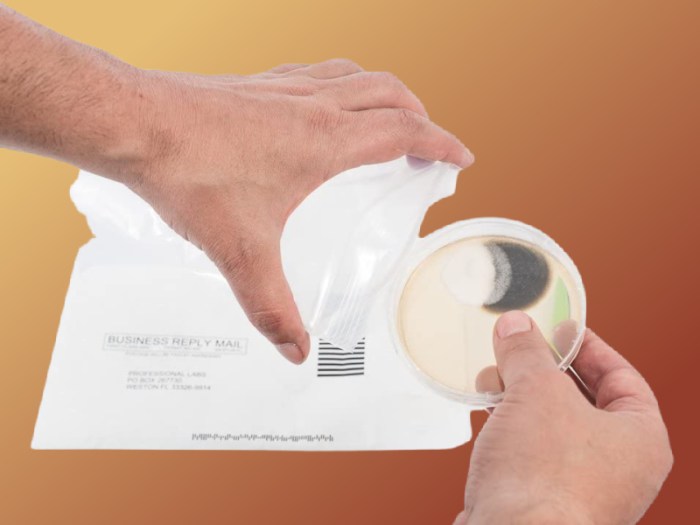DIY mold test kits have become increasingly popular as homeowners seek to identify and address potential mold issues in their homes. These kits offer a convenient and affordable way to test for mold, but it’s important to understand their limitations and use them correctly.
Table of Contents
Mold can be a serious health hazard, and its presence in your home can trigger allergies, respiratory problems, and even more severe health complications. This guide will explore the different types of DIY mold test kits available, how to use them effectively, and when it’s best to consult a professional mold inspector.
Common Mold Types and Their Characteristics
Mold is a type of fungus that can grow in damp, humid environments. It can be found indoors and outdoors, and it can cause health problems if it is not addressed. Mold spores are microscopic and can be found in the air, which means that they can easily spread from one place to another. When mold spores land on a damp surface, they can germinate and begin to grow. Mold can grow on a variety of surfaces, including wood, drywall, carpet, and fabric.
Common Mold Types
The most common types of mold found in homes include:
- Cladosporium: This is one of the most common types of mold found in homes. It is typically black or dark green in color and has a fuzzy appearance. Cladosporium can grow on a variety of surfaces, including wood, drywall, carpet, and fabric. It can cause allergic reactions, such as sneezing, coughing, and watery eyes. It can also cause respiratory problems, such as asthma and bronchitis.
- Penicillium: This type of mold is typically green, blue, or yellow in color and has a fuzzy appearance. It can grow on a variety of surfaces, including wood, drywall, carpet, and fabric. Penicillium can cause allergic reactions, such as sneezing, coughing, and watery eyes. It can also cause respiratory problems, such as asthma and bronchitis.
- Aspergillus: This type of mold is typically green, black, or brown in color and has a fuzzy appearance. It can grow on a variety of surfaces, including wood, drywall, carpet, and fabric. Aspergillus can cause allergic reactions, such as sneezing, coughing, and watery eyes. It can also cause respiratory problems, such as asthma and bronchitis. In some cases, Aspergillus can cause serious infections in people with weakened immune systems.
- Alternaria: This type of mold is typically black or brown in color and has a fuzzy appearance. It can grow on a variety of surfaces, including wood, drywall, carpet, and fabric. Alternaria can cause allergic reactions, such as sneezing, coughing, and watery eyes. It can also cause respiratory problems, such as asthma and bronchitis.
- Stachybotrys: This type of mold is typically black or dark green in color and has a slimy appearance. It is often called “black mold” and is known to produce toxins that can be harmful to human health. Stachybotrys can grow on damp surfaces, such as wood, drywall, and carpet. It can cause a variety of health problems, including respiratory problems, allergic reactions, and neurological problems.
Characteristics of Common Mold Types
| Mold Type | Appearance | Growth Pattern | Health Risks |
|---|---|---|---|
| Cladosporium | Black or dark green, fuzzy | Can grow on a variety of surfaces | Allergic reactions, respiratory problems |
| Penicillium | Green, blue, or yellow, fuzzy | Can grow on a variety of surfaces | Allergic reactions, respiratory problems |
| Aspergillus | Green, black, or brown, fuzzy | Can grow on a variety of surfaces | Allergic reactions, respiratory problems, infections |
| Alternaria | Black or brown, fuzzy | Can grow on a variety of surfaces | Allergic reactions, respiratory problems |
| Stachybotrys | Black or dark green, slimy | Grows on damp surfaces | Respiratory problems, allergic reactions, neurological problems |
DIY Mold Test Kits

DIY mold test kits offer a convenient and affordable way to assess the presence of mold in your home. These kits are typically easy to use, and they can provide a quick and preliminary indication of mold contamination. However, it’s crucial to understand that DIY kits are not substitutes for professional mold inspections. They are best used for initial screening and to help you decide if further professional assessment is necessary.
Popular DIY Mold Test Kits and Consumer Reviews
Here are some of the most popular DIY mold test kits available on the market, along with consumer reviews and ratings:
- Mold Armor Mold Test Kit: This kit utilizes a swab to collect mold samples, which are then sent to a lab for analysis. Consumers praise its ease of use and the detailed results provided. However, some users have reported delays in receiving results. Average rating: 4.5 stars.
- EZ Test Mold Test Kit: This kit features a simple swab-and-send approach, with results available within 5-7 business days. Users appreciate its affordability and the comprehensive report that identifies the specific types of mold found. However, some have expressed concerns about the accuracy of the results. Average rating: 4 stars.
- First Alert Mold Test Kit: This kit offers a two-step process: a swab for visual inspection and a petri dish for culturing mold samples. Users find it easy to use and appreciate the dual approach. However, some have noted that the petri dish method can be less reliable. Average rating: 3.5 stars.
- Air Quality Test Kit: This kit measures the presence of mold spores in the air, providing an indication of potential mold contamination. Consumers appreciate its ability to assess overall air quality. However, it may not be as effective in identifying localized mold problems. Average rating: 4 stars.
It’s important to note that consumer reviews and ratings can vary significantly depending on individual experiences and expectations. When selecting a DIY mold test kit, consider factors such as ease of use, accuracy, turnaround time, and cost.
Recommendations for DIY Mold Test Kits
- For a comprehensive and accurate assessment, consider the Mold Armor Mold Test Kit or the EZ Test Mold Test Kit. These kits offer detailed lab analysis and provide valuable insights into the types of mold present.
- If you’re looking for a budget-friendly option, the First Alert Mold Test Kit provides a basic visual inspection and a culturing method. However, be aware that the petri dish method may not be as reliable as lab analysis.
- For a general assessment of air quality, the Air Quality Test Kit can be helpful in identifying potential mold contamination. However, it may not be suitable for detecting localized mold problems.
Remember that DIY mold test kits are just a starting point. If you suspect mold contamination, it’s always best to consult a qualified mold inspector for a professional assessment and remediation plan.
Resources and Further Information

This section provides a list of reputable resources for additional information on mold testing and remediation. You can find websites, articles, and organizations that offer guidance on mold-related issues.
Relevant Resources
These resources can provide further information on mold testing, remediation, and related topics:
- Environmental Protection Agency (EPA): The EPA offers comprehensive information on mold, including guidance on mold testing, remediation, and prevention. Their website provides a wealth of resources, including fact sheets, publications, and videos. https://www.epa.gov/mold
- American Academy of Allergy, Asthma & Immunology (AAAAI): The AAAAI provides information on mold allergies and health risks associated with mold exposure. Their website includes articles, resources, and information on finding an allergist in your area. https://www.aaaai.org/
- National Center for Environmental Health (NCEH): The NCEH offers guidance on mold-related health risks and provides information on how to prevent mold growth in your home. Their website includes fact sheets, publications, and resources on mold-related health issues. https://www.cdc.gov/nceh/
- American Industrial Hygiene Association (AIHA): The AIHA provides information on mold testing, remediation, and industrial hygiene practices related to mold. Their website includes resources, publications, and guidance on mold management in workplaces. https://www.aiha.org/
- National Mold Testing & Remediation Association (NMTARA): NMTARA is a professional association for mold testing and remediation professionals. Their website provides information on mold testing, remediation, and certification programs. https://www.nmtara.org/
While DIY mold test kits can be a helpful tool for initial detection, remember that professional mold inspections are essential for accurate diagnosis and effective remediation. By understanding the pros and cons of both options, you can make informed decisions about your home’s health and safety.
DIY mold test kits are a great way to check for potential mold problems in your home. They can be especially helpful if you have concerns about your health, such as diabetes, which is sometimes treated with medications like Trajenta 5 mg. While mold can be a health concern, it’s important to remember that a positive test doesn’t necessarily mean you need professional remediation.
Always consult with a qualified professional for further advice.


